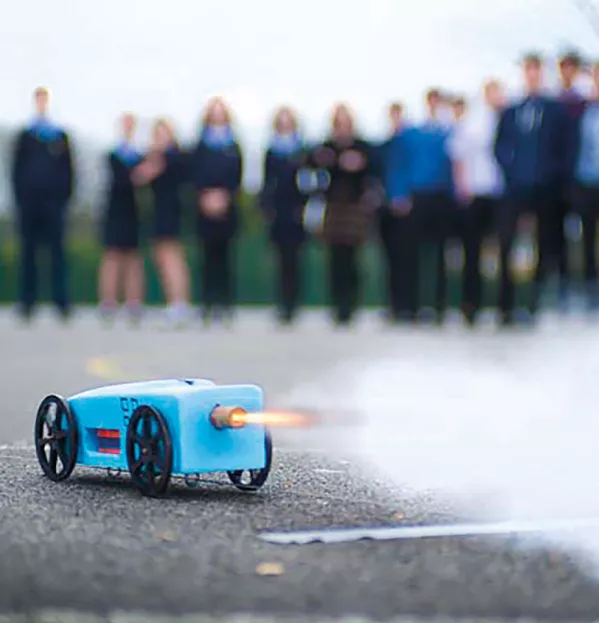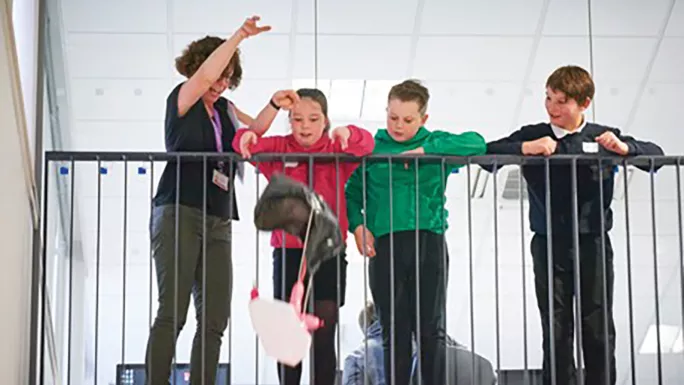Young bloodhounds on the scent of a Stem career

Thousands of primary pupils are gaining their first experience of college this year as part of a science, technology, engineering and maths (Stem) initiative in Edinburgh.
Over the course of the school year, Edinburgh College’s Stem P7 Inspiration Project will involve over 2,400 pupils - from the capital, East Lothian and Midlothian - visiting the college for a day of projects and experiments, as well as some classroom-based work. This year’s initiative marks a significant expansion from the 400-pupil pilot last year.
Tasks include the “Bloodhound challenge” - inspired by the British car built to break the land speed record by hitting more than 1,000mph (pictured below) - to design a high-speed model vehicle, experimenting with g-force and electricity. They will also build a model bridge, in a test of engineering skills and teamwork.

Organised mostly through secondary schools for their primary school cluster, the scheme acts as a transition project, allowing children to not only experience college first-hand, but also to meet other children who’ll attend the same secondary and their future teachers.
Deborah Robertson, Edinburgh College’s project lead for Developing the Young Workforce, told Tes Scotland that the scheme was intended to be a four-year transition project - meaning it would be expanded to allow pupils to come to the college in P7, S1, S2 and S3. She said that the project was originally inspired both by the demand for colleges to focus on Stem in the government’s Developing the Young Workforce strategy, and a desire to engage learners as early as possible.

“Schools seem to really see the value in this - there is huge demand,” she said. The next step will be to expand the project to the other Edinburgh College campuses, beyond the engineering faculty. “The challenge will be for lecturers to see how it could fit in with their subject areas,” said Ms Robertson.
Ross High School in East Lothian was the first to be involved last year. Headteacher Paul Reynolds said this had been part of the school’s “year of careers”, which focused on Stem. Getting pupils from nine cluster primary schools to the college had been a logistical challenge, he added. However, the school is now expanding its involvement, with plans to send both P7s and S1s who had already visited the college last year. Next year, P7-S2 will be involved.
‘The workforce of the future’
Placing the project in the college added “an aspirational element”, Mr Reynolds said, as well as access to resources that the school could not offer. “We now have a Stem group and Stem ambassadors, and all of that kind of came about because our year of careers was kickstarted by the work with the college.”

The P7 project is part of a wider strategy by the college, which last week launched its Stem manifesto.
It pledges to ensure that Stem is given prominence and status in the college and the community it serves, and that it will strengthen “the skills pipeline of learners from schools to employment and higher education”.
The college also recently gained “Stem-assured” status, the eighth Scottish college to do so. The launch took place the day before the Scottish government published its new Stem strategy.
Annette Bruton, principal of Edinburgh College, said: “All businesses and industries are being changed rapidly by emerging technologies. It’s essential that we inspire the workforces of the future at as young an age as possible. Our Stem P7 Inspiration Project is giving young people the opportunity to learn about how science, technology, engineering and maths are impacting on our daily lives and shaping our changing world.”
She said that the college was offering practical learning to make the experience “really engaging and fun”, adding: “It’s actually been inspiring for ourselves to see how much they have been enjoying it and how much they’re learning. The feedback from schools has been fantastic. Taking pupils into the college environment and letting them experiment has been really valuable, and is getting them thinking about future career paths already.”
You need a Tes subscription to read this article
Subscribe now to read this article and get other subscriber-only content:
- Unlimited access to all Tes magazine content
- Exclusive subscriber-only stories
- Award-winning email newsletters
Already a subscriber? Log in
You need a subscription to read this article
Subscribe now to read this article and get other subscriber-only content, including:
- Unlimited access to all Tes magazine content
- Exclusive subscriber-only stories
- Award-winning email newsletters